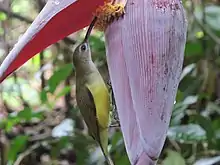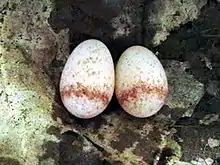| Little spiderhunter | |
|---|---|
 | |
| A. l. longirostra (Sabah, Borneo) | |
| Scientific classification | |
| Domain: | Eukaryota |
| Kingdom: | Animalia |
| Phylum: | Chordata |
| Class: | Aves |
| Order: | Passeriformes |
| Family: | Nectariniidae |
| Genus: | Arachnothera |
| Species: | A. longirostra |
| Binomial name | |
| Arachnothera longirostra (Latham, 1790) | |
The little spiderhunter (Arachnothera longirostra) is a species of long-billed nectar-feeding bird in the family Nectariniidae found in the moist forests of South and Southeast Asia. Unlike typical sunbirds, males and females are very similar in plumage. They are usually seen in ones or twos and frequently make a tzeck call. They are most often found near flowering plants where they obtain nectar.
Description
The distinctive long beak set it apart from other sunbirds. The sexes are similar, except that the female has a paler base on the lower mandible. Male has all black beak.[2] They are found near their favourite nectar bearing trees, often species of wild Musaceae or flowers in gardens. They have a buzzy zick-zick call that is made regularly when disturbed or when foraging. Additionally, the song is series of rapid chipping notes and these can go on for long periods.[2]
Taxonomy
The genus name Arachnothera means "spider hunter" and the species epithet refers to the long beak. About thirteen geographic races are recognized. The nominate race longirostra (Latham, 1790) is found in southwestern India, central and northeastern India, foothills of the Himalayas and into Thailand and Yunnan. Race sordida La Touche, 1921 is found in southern China and northeastern Thailand. Race pallida Delacour, 1932 is found in eastern Thailand and C & S Indochina. Two species from the Philippines, the orange-tufted and the pale spiderhunter were formerly considered subspecies. Several other island forms are noted:[3]
- cinereicollis (Vieillot, 1819) - south of the Isthmus of Kra to Sumatra and satellite islands
- zarhina Oberholser, 1912 - Banyak Is, off W Sumatra.
- niasensis van Oort, 1910 - Nias I, off W Sumatra.
- rothschildi van Oort, 1910 - N Natuna Is.
- atita Oberholser, 1932 - S Natuna Is.
- buettikoferi van Oort, 1910 - Borneo.
- prillwitzi Hartert, 1901 - Java (including Madura I) and Bali[4]
- randi Salomonsen, 1953 - Basilan (off W Mindanao).
Distribution and habitat

The species is found in Bangladesh, Bhutan, Brunei, Cambodia, China, India, Indonesia, Laos, Malaysia, Myanmar, Nepal, Philippines, Thailand, and Vietnam. Within India, there are disjunct populations in the Eastern Ghats from Lamasinghi,[5] Visakhapatnam and parts of Orissa[6]) and the Western Ghats apart from the main distribution in north-east India that extends into Southeast Asia.[7] A record from the Nicobar Islands is considered doubtful.[2]
Its natural habitats are subtropical or tropical moist lowland forests, subtropical or tropical mangrove forests, and subtropical or tropical moist montane forests. It is usually found below the canopy. They are also found in gardens, attracted especially by flowers that yield nectar.[8]
Behaviour and ecology
They have been noted as good pollinators of wild banana species[9] and several species of the ginger family[10] and often visit Loranthus sp. (= Dendrophthoe sp.),[11] Bombax malabaricum and Erythrina indica for nectar.[12][13] They are often seen in plantations in forest areas.[14][15] Although they are more often seen in secondary forests or in clearings and appear to be tolerant of human activities, they have become extinct in some forest fragments. In Singapore they have gone locally extinct within the botanical garden.[16]

The breeding season in northeastern India is March to September but mainly May to August. In southern India it breeds from December to August. Two eggs are the usual clutch.[7] The nest is a compact cup attached under a leaf of banana or similar broad leaved plant. The nest is suspended from the underside of the leaf using 150 or so "pop-rivets" of cobwebs and vegetable fibre, a unique method of using spider silk for animal architecture.[18]
It is suspected that Hodgson's hawk-cuckoo and violet cuckoo are brood parasites on this species in India.[19]
A species of haemosporidian, Leucocytozoon, has been noted in specimens from Malaysia.[20]
In culture
In Sarawak, the Kayan, Kenyah and Punan people consider it a bird of good omen and when they are out collecting camphor, the men would wait until they heard the sit call of one of these spiderhunters.[21]
References
- ↑ BirdLife International (2016). "Arachnothera longirostra". IUCN Red List of Threatened Species. 2016: e.T103778625A94567188. doi:10.2305/IUCN.UK.2016-3.RLTS.T103778625A94567188.en. Retrieved 15 November 2021.
- 1 2 3 Rasmussen PC & JC Anderton (2005). Birds of South Asia: The Ripley Guide. Volume 2. Smithsonian Institution & Lynx Edicions. p. 550.
- ↑ Rahman, MA; DFA Gawin; C Moritz (2010). "Patterns of genetic variation in the little spiderhunter (Arachnothera longirostra) in Southeast Asia" (PDF). The Raffles Bulletin of Zoology. 58 (2): 381–390. Archived from the original (PDF) on 2014-08-08.
- ↑ Hartert E (1901). "Some notes on Java birds". Novitates Zoologicae. 8: 49–53.
- ↑ Raju, KSR Krishna; Selvin, Justus P (1971). "Little Spiderhunter, Arachnothera longirostris (Latham) in the Eastern Ghats". J. Bombay Nat. Hist. Soc. 68 (2): 454–455.
- ↑ Majumdar,N (1979). "New records of birds from Orissa". J. Bombay Nat. Hist. Soc. 76 (1): 161–162.
- 1 2 Ali, S & SD Ripley (1999). Handbook of the birds of India and Pakistan. Volume 10 (2nd ed.). Oxford University Press. pp. 55–56.
- ↑ Beehler,B; Raju, KSRK; Ali,Shahid (1987). "Avian use of man-disturbed forest in the Eastern Ghats, India". Ibis. 129 (2): 197–211. doi:10.1111/j.1474-919X.1987.tb03201.x.
- ↑ Liu Ai-Zhong; Li De-Zhu; Hong Wang; Kress W. John (2002). "Ornithophilous and chiropterophilous pollination in Musa itinerans (musaceae), a pioneer species in tropical rain forests of Yunnan, Southwestern China". Biotropica. 34 (2): 254–260. doi:10.1646/0006-3606(2002)034[0254:oacpim]2.0.co;2.
- ↑ Sakai, Shoko; Kato, Makoto; Inoue, Tamiji (1999). "Three pollination guilds and variation in floral characteristics of Bornean gingers (Zingiberaceae and Costaceae)". Am. J. Bot. 86 (5): 646–658. doi:10.2307/2656573. JSTOR 2656573. PMID 10330067.
- ↑ Devasahayam S, Rema J (1993). "Flower birds of Kozhikode District, Kerala". Newsletter for Birdwatchers. 33 (6): 103–105.
- ↑ Devasahayam S, Rema J (1993). "Birds visiting flowers of Indian silk cotton tree (Bombax malabaricum) at Calicut, Kerala". In Verghese A, Sridhar S, Chakravarthy AK (eds.). Bird Conservation, Strategies for the Nineties and Beyond. Ornithological Society of India, Bangalore. pp. 184–185.
- ↑ Devasahayam S, Rema J (2003). "Bird visitors to flowers of Indian coral tree (Erythrina indica Lam.) at Kozhikode District, Kerala". Newsletter for Birdwatchers. 43 (5): 72–73.
- ↑ Daniels, R J R; Malati Hegde & Madhav Gadgil (1990). "Birds of man-made ecosystems: the plantations". Proceedings: Animal Sciences. 99 (1): 79–89. doi:10.1007/BF03186376. S2CID 129118660.
- ↑ Ranganathan, J.; R. J. Ranjit Daniels; M. D. Subash Chandran; Paul R. Ehrlich & Gretchen C. Daily (2008). "Sustaining biodiversity in ancient tropical countryside". Proc. Natl. Acad. Sci. U.S.A. 105 (46): 17852–17854. doi:10.1073/pnas.0808874105. PMC 2577706. PMID 18981411.
- ↑ Navjot S. Sodhi; Tien Ming Lee; Lian Pin Koh & Robert R. Dunn (2005). "A century of avifaunal turnover in a small tropical rainforest fragment" (PDF). Animal Conservation. 8 (2): 217–222. doi:10.1017/S1367943005001927. Archived from the original (PDF) on 2008-09-05.
- ↑ Baker, ECS (1901). "On Indian birds' eggs and their variations". Ibis. 8 (1): 411–423. doi:10.1111/j.1474-919X.1901.tb00474.x.
- ↑ Hansell, Michael Henry (2007). Built by animals: the natural history of animal architecture. Oxford University Press. pp. 19–21. ISBN 978-0-19-920556-1. Retrieved 1 July 2011.
- ↑ Robert B. Payne; Michael D. Sorenson; Karen Klitz (2005). The Cuckoos : Cuculidae. Oxford University Press. p. 390. ISBN 0198502133.
- ↑ Paperna, Ilan (2008). "Haemosporozoan parasites found in birds in Peninsular Malaysia, Singapore, Sarawak and Java" (PDF). The Raffles Bulletin of Zoology. 56 (2): 211–243. Archived from the original (PDF) on 2011-06-06.
- ↑ Haddon, AC (1901). Head-hunters: Black, white and brown. Methuen and Co., London. pp. 390–391.
Other references
- Rahman, M. A. 2006. Patterns of morphological variation in the little spiderhunter (Arachnothera longirostra) in Taman Negara, Peninsular Malaysia and Thale Ban National Park, Thailand. In: Othman, S., Yatim, S. H., Elagupillay, S., Md. Nor, S., Ahmad, N., and Mohd Sah, S. H (eds.), Pp: 207–214, Management and Status of Resources in Protected Areas for Peninsular Malaysia. Department of Wildlife and National Parks, Kuala Lumpur. ISBN 983-43010-0-6.
- Khan, AR (1977): Territoriality among Sunbirds and Spiderhunter. Newsletter for Birdwatchers . 17(1), 5–6.
- Law, SC (1945). "Note on the occurrence of some hitherto unrecorded birds in central and South Bengal". Ibis. 87 (3): 405–408. doi:10.1111/j.1474-919x.1945.tb01372.x.
